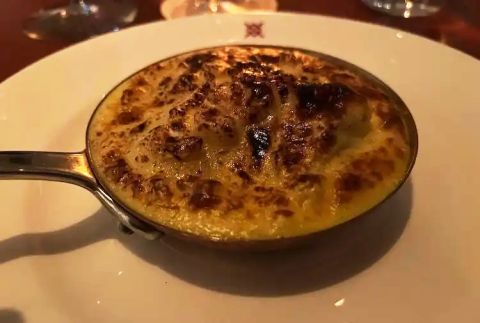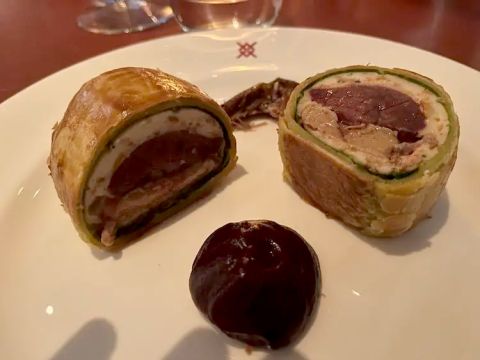There has always been a close link between restaurants and the art on their walls, with the latter often illuminating the restaurant’s history.
At Kronenhalle restaurant in Zurich, Switzerland, there are several works by Chagall, Braque, Bonnard and Miro collected in the 1940s by the perspicacious restaurateur Gustav Zumsteg. At La Colombe d’Or in St-Paul de Vence in France there are paintings by Picasso, Chagall and Calder.
The link between the art world and good food has always been close. I can remember as a restaurateur in London in the 1980s welcoming the Zwemmers who kept the art bookshop on Charing Cross Road and the directors of Thames & Hudson, the art book publishers, as frequent customers. On Monday evenings every month at L’Escargot we changed the works of art by different artists to enliven the quietest night of the week, and decorate the pale-green walls.
Recently, these links became even stronger. Matthew Slotover and his business partner Amanda Sharp who founded Frieze Art Fair spent several years plotting Toklas, their elegant restaurant just off The Strand, and he has gone on to open the newly restored Fort Road Hotel in Margate, Kent, whose walls boast works of art in many different media.
Toklas has now been joined by the first London opening from Artfarm as the reopened Audley Public House with Mount Street Restaurant on its first floor and a couple of private dining rooms on the floors above.
Artfarm is the name of the company founded by Iwan and Manuela Wirth, who originally opened the first Hauser & Wirth gallery in Switzerland in 1990. Today they represent over 90 artists in galleries around the world. When they opened a gallery close to Bruton in Somerset they also opened a restaurant, Roth, where we ate well in 2019, and this association has obviously whetted their appetites because they have also since opened restaurants in Scotland and Los Angeles. In this process they have also managed to lure CEO Ewan Venters away from Fortnum & Mason.
The pub and restaurant are located on the corner of what must be London’s most expensive street. They are surrounded by outposts of the Richard Caring empire: Scott’s is a neighbour, the still-boarded-up George is opposite, and Harry’s Bar is 150 metres away. The Connaught Hotel is just at the end of the street. So if a restaurateur’s main challenge is to match the outside of the front door with what is on the inside, then Artfarm faced a major challenge. By and large they have met the challenge, even if there is still too much of a sense of formality about the first-floor restaurant.
The ground-floor renovation has been sensitively done, keeping such small pieces of the former interior as the box where the bells rang indicating which room needed a member of staff, but improving the food substantially as well as widening the drinks offer. I can heartily recommend the Wandle bitter from Sambrook’s brewery in Wandsworth as well as the Italian Menabrea lager. The food menu is interesting but an open sandwich of bone marrow and a bowl of London Particular soup were let down by neither being served quite hot enough.
The small, separate, decidedly discreet entrance to the restaurant, on Mount Street, immediately leads to a 30-step steep climb (and it is down a further 20 steps to the lavatories although there is a lift), although the narrow staircase’s walls are at least enlivened by closely packed works of art. The staircase leads into a narrow vestibule, home to a smartly dressed waiting committee, which then opens up into the restaurant.
The view as you walk in is most impressive. There is a series of windows which reveal a glamorous view down South Audley Street and across Mount Street with one corner table for four particularly appealing as it’s in a sort of windowed turret. The floor is almost as eye-catching: a palladiana mosaic called Broken Floor by artist Rashid Johnson, which is unlike any other floor covering I have ever seen in a working restaurant for pretty obvious reasons. Once anything falls on it, it is unlikely to survive in one piece.
Then there is the art, which is impressive and has been hung thoughtfully. On the walls are Lucian Freud’s Self Portrait: Reflection (1996) and A Plate of Prawns (1958), Andy Warhol’s Lobster (1982), Matisse’s Éperlans (Smelts) (1920 executed in Étretat), Frank Auerbach’s Primrose Hill, Summer (1968), Georgio Morandi’s Natura morta (1946) and Keith Tyson’s Still Life with White Carbs (2022). This is the sort of collection of which any aspiring restaurateur can only dream.
Art and design are integrated throughout. The extremely heavy table lamps are inspired by the iconic 1918 Powder Box by the late Swiss artist Sophie Taeuber-Arp, the salt and pepper sets are inspired by American artist Paul McCarthy’s Tree sculpture of 2014. The extremely light, comfortable – and very expensive – dining chairs are by American artist Matthew Day Jackson, which complement the bespoke aniline leather table tops, which are slightly too wide so that at a table for two you are sitting slightly too far from your companion. They are designed by Bill Amberg Studio. The bill for all this, plus the modernisation of the five-storey building, must be truly eye-watering.
Chef Jamie Shears does not let the fact that he and his brigade are hidden away in the basement kitchen get them down, writing and delivering a menu that combines certain favourites – there is a Dover sole, a ribeye steak with chips as well as salmon smoked in Stepney – but the most obvious fact about his menu is the prevalence of vegetarian dishes. There is a salad of London butter lettuce, Stilton, pear and walnuts; another of leeks vinaigrette with smoked almonds as well as a Jerusalem artichoke soup with mushrooms on toast while his main dishes include a beetroot tart with goat’s curd, a dish of foraged mushroom and spelt with celeriac, and a warm salad of pumpkin, artichokes and pumpkin-seed pesto.
Then there are dishes I have not seen for a long while. Shears’ menu opens with an omelette Arnold Bennett (above), which was rich and satisfying, and I followed this with a dish listed as pigeons in Pimlico, duck liver, bacon and red cabbage. This, it transpired, is an 18th-century recipe from Hannah Glasse, the somewhat ignored English cookery writer. Shears’ modern interpretation of this (below) involved two neatly cut pieces of thin pastry enclosing the pigeon meat shot through with the duck liver. On top of one lay a crisp pigeon leg and alongside a ball of red cabbage. It was extremely good but also very rich. Desserts were a lemon tart (excellent filling on less-good pastry) and also a rarely seen raspberry blancmange that was slightly too solid, the consequence perhaps of too much gelatin. These are problems that can easily be solved with time – the restaurant opened as recently as 12 October.
The wine list is full of smart names and prices are distinctly Mayfair. We drank a couple of excellent margaritas (£15 each), before a glass each of Villard Condrieu (£23), 2019 Oremus Dry Furmint (£15) and Caparzo Brunello (£19), each elegantly served in JR wine glasses by a young Polish female sommelier, who explained that the management had chosen these glasses as much for their looks as for the fact that they had very little storage space. My bill for two without coffee came to £257.62.
The Audley Public House and The Mount Street restaurant are a very smart, welcome addition to Mayfair, with the pub likely to be the more profitable of the two.
The Audley Public House 41–43 Mount Street, London W1K 2RX; tel: +44 (0)20
Mount Street Restaurant First Floor 41–43 Mount Street, London W1K 2RX; tel: +44 (0)20 3840 9860
















